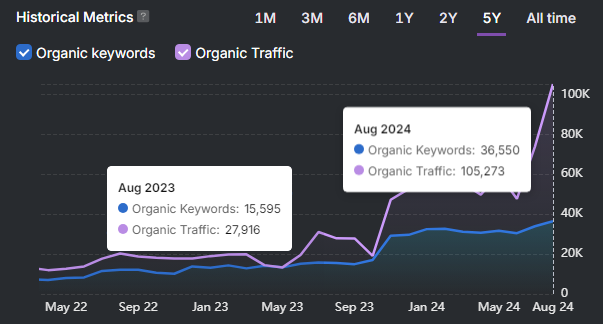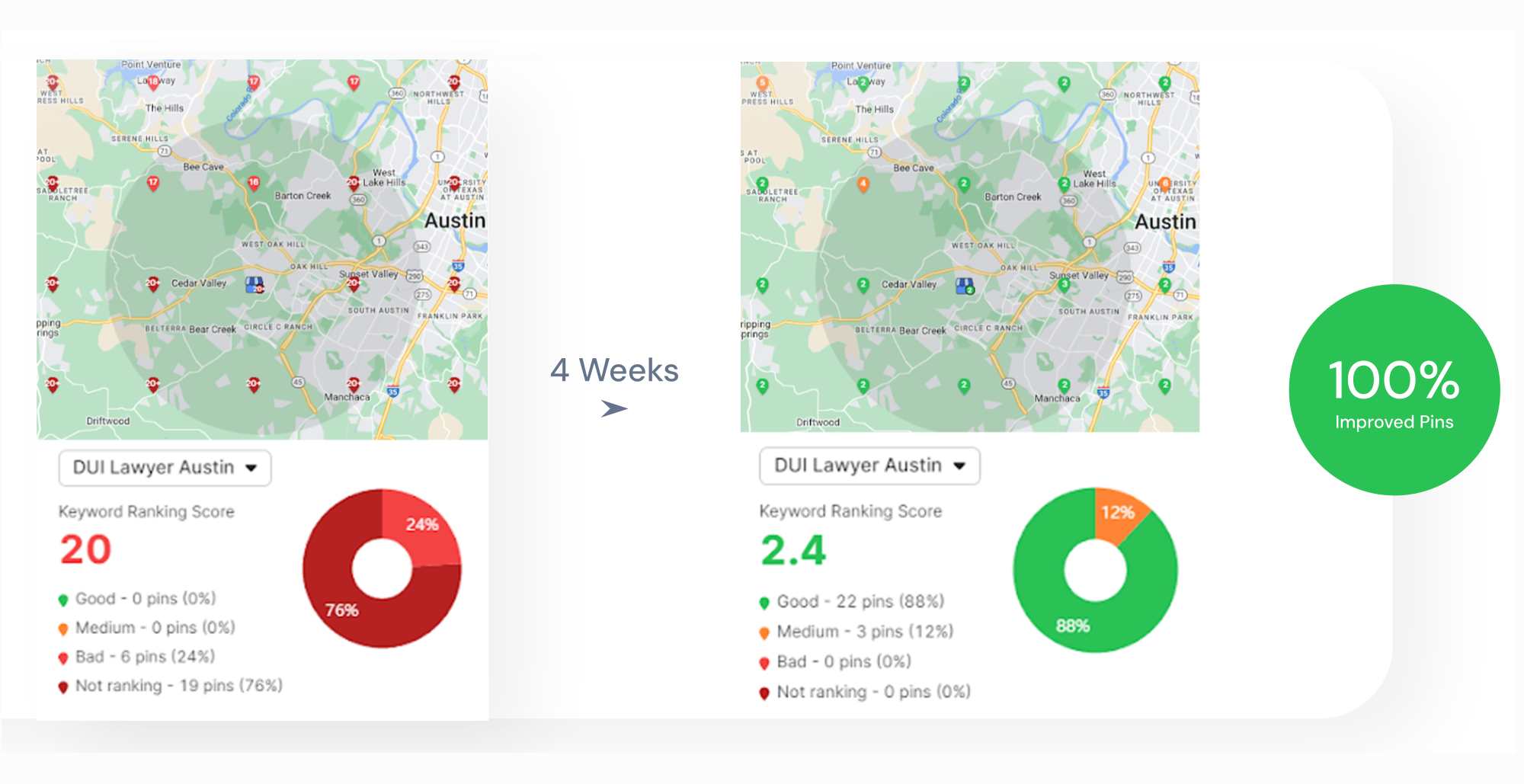DIY SEO refers to the practice of optimizing your website for search engines without the assistance of professional SEO agencies or consultants. DIY search engine optimization involves learning, implementing, and managing SEO strategies on your own to improve your website’s visibility in search engine results pages (SERPs).
The benefits of the do SEO yourself approach are that it allows businesses to remain competitive in their niche, build domain authority, and directly align their content and SEO efforts with business goals. DIY SEO can be a sustainable and rewarding approach to long-term digital growth with commitment, consistency, and the right resources. This do-it-yourself SEO guide is designed to help individuals and businesses take control of their website’s search performance without relying on agencies or expensive consultants.
What is Do It Yourself (DIY) SEO?
Do-it-yourself (DIY) SEO is the process of optimizing your website for search engines without the help of professional SEO agencies or consultants. DIY SEO implies taking full responsibility for learning and applying SEO strategies on your own, instead of outsourcing the work. This hands-on approach is popular among small business owners, bloggers, startups, and individuals who want to improve their website’s visibility on search engines while keeping costs low.
DIY SEO optimization involves understanding how search engines work and using that knowledge to make your website more attractive to both users and search engine algorithms. Effective DIY SEO marketing allows you to take control of your online presence, experiment with different techniques, and monitor the results firsthand. Most people practicing DIY SEO typically learn through online resources, tutorials, documentation, and trial-and-error experimentation with their own websites.
What is the Importance of DIY SEO for Small Businesses?
DIY SEO plays a crucial role in helping small businesses build a strong online presence without the high costs associated with hiring professional SEO agencies. The DIY SEO process allows many small business owners operating on tight budgets to invest in long-term growth while maintaining financial control. Following the do-it-yourself approach helps small businesses improve their website’s visibility in search engine results, attract more local and targeted traffic, and ultimately increase leads and sales.
Effective DIY SEO offers a high level of control and flexibility. Small business owners can implement strategies at their own pace, test different approaches, and make immediate changes based on performance. Additionally, this hands-on involvement helps small business owners develop a deeper understanding of their audience, content strategy, and marketing goals. Over time, this knowledge becomes a valuable asset, empowering small business owners to make informed decisions and adapt quickly to changing search engine trends.
The DIY small business SEO strategy encourages small business owners to focus on high-quality, relevant content that genuinely serves their audience. This focus improves search rankings as well as builds trust and credibility with potential customers. Additionally, staying actively engaged in their website’s optimization helps small business owners create a more personalized and authentic brand experience, which can lead to stronger customer relationships and long-term loyalty.
What Are the Benefits of Do It Yourself (DIY) SEO?
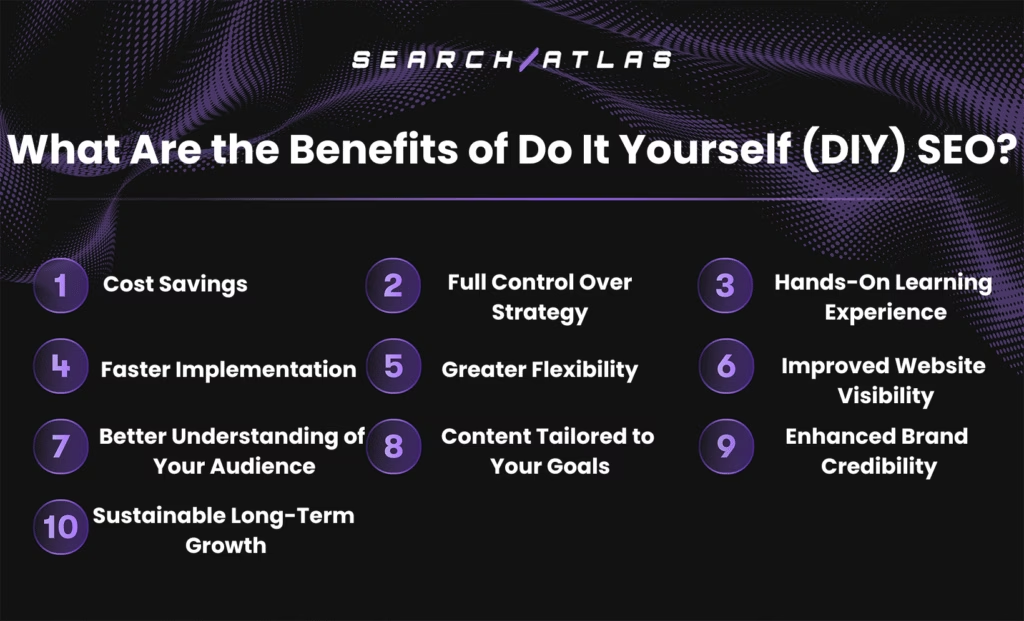
There are 10 benefits of DIY SEO for individuals and businesses looking to boost their online visibility without outsourcing to agencies or consultants. The 10 benefits of the do-your-own-SEO approach are listed below.
- Cost Savings. DIY SEO eliminates the need to hire expensive consultants or agencies, making it a budget-friendly option for startups and small businesses.
- Full Control Over Strategy. DIY SEO enables you to have complete control over how, when, and where SEO strategies are applied to your website, allowing for more personalized and responsive decision-making.
- Hands-On Learning Experience. Managing your own SEO helps you gain valuable skills and a deeper understanding of how search engines work, which can benefit other areas of digital marketing.
- Faster Implementation. Doing your own SEO enables you to make immediate changes and optimizations based on your website’s performance and analytics, without relying on external help.
- Greater Flexibility. DIY SEO allows you to test, adjust, and refine strategies at your own pace, which is ideal for adapting to trends or algorithm updates.
- Improved Website Visibility. Following the do-it-yourself SEO approach can significantly improve your search engine rankings with consistent effort, increasing your chances of being discovered by new audiences.
- Better Understanding of Your Audience. Doing your own SEO forces you to research what your audience is searching for, leading to more relevant and engaging content.
- Content Tailored to Your Goals. Taking the do-it-yourself SEO steps helps you create content that directly aligns with your goals and audience needs since you understand your business best.
- Enhanced Brand Credibility. Higher rankings and well-optimized content create a more trustworthy and professional image in the eyes of potential customers.
- Sustainable Long-Term Growth. DIY search engine optimization is an ongoing effort that, over time, builds a solid foundation for lasting online visibility and steady traffic growth.
DIY SEO is a powerful option for those who are willing to invest time and effort into understanding how search engines work. The hands-on approach may come with a learning curve, but its long-term benefits make it a worthwhile strategy for small businesses and individuals.
How to Do SEO Yourself?
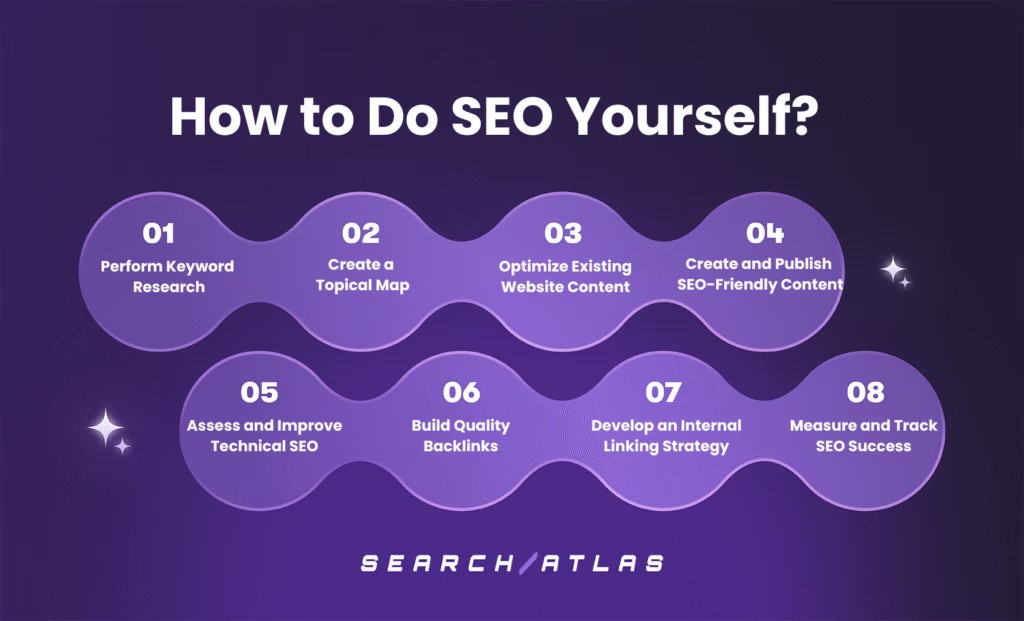
There are 8 steps to do SEO yourself and gradually improve your website’s visibility and attract more organic traffic. The 8 DIY SEO easy steps are outlined below.
1. Perform Keyword Research
Keyword research is the process of identifying the words and phrases that people enter into search engines when looking for information, products, or services related to your business. These keywords help guide your content strategy, SEO efforts, and marketing decisions by targeting what your audience is actively searching for online.
Performing keyword research is one of the most important steps in any SEO or content marketing strategy. Performing keyword research helps you attract visitors who are specifically looking for the products, services, or information you offer. Using relevant keywords in your content increases your chances of ranking higher on Google and other search engines. Conducting keyword research reveals gaps in existing content, helping you create new pages or blog posts that address unmet search needs. Additionally, carrying out keyword research helps you understand user intent, so you can tailor your content to meet your audience’s needs more effectively.
To perform keyword research, understand who your target audience is and what they are searching for. Use tools like Google Keyword Planner or the Search Atlas Keyword Research Tool to find relevant keywords. Target long-tail keywords that are more specific and less competitive. Ensure the keywords you choose match the search intent behind the query. Check keyword difficulty to balance high-volume terms with realistic opportunities.
Additionally, use tools like the Search Atlas Keyword Gap Tool to discover keywords your competitors currently rank for but you don’t. Organize your keywords into topical clusters to support content planning. Monitor keyword trends to stay updated on what is gaining interest. Regularly review and update your keyword list as search behavior evolves.
The Search Atlas Keyword Research Tool helps you identify emerging keyword opportunities to help you stay ahead of SEO trends and capture traffic early in the search cycle. The Search Atlas Keyword Research Tool provides comprehensive insights into key metrics such as search volume, cost-per-click (CPC), keyword difficulty, top-ranking pages, and related keyword suggestions. Additionally, the Search Atlas Keyword Research Tool empowers you to explore keyword variations, semantically related terms, and commonly asked questions to help you build a more targeted, high-performing SEO strategy.
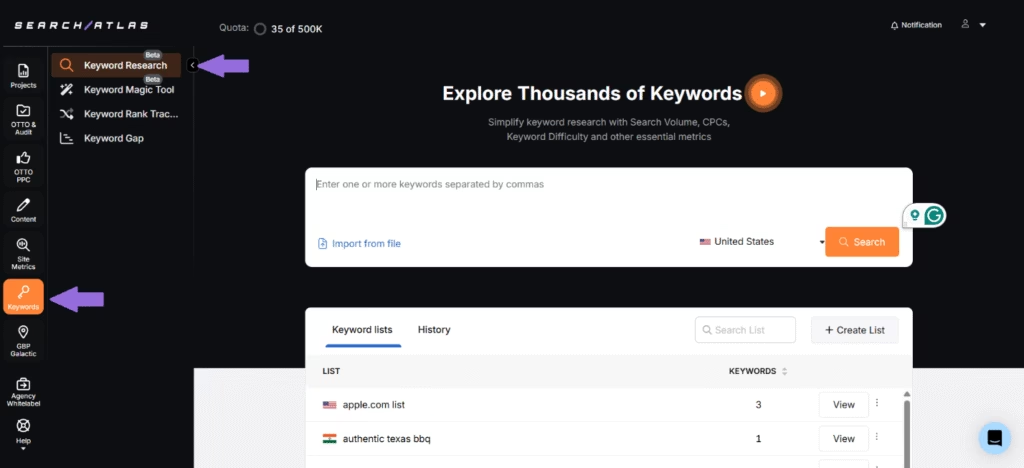
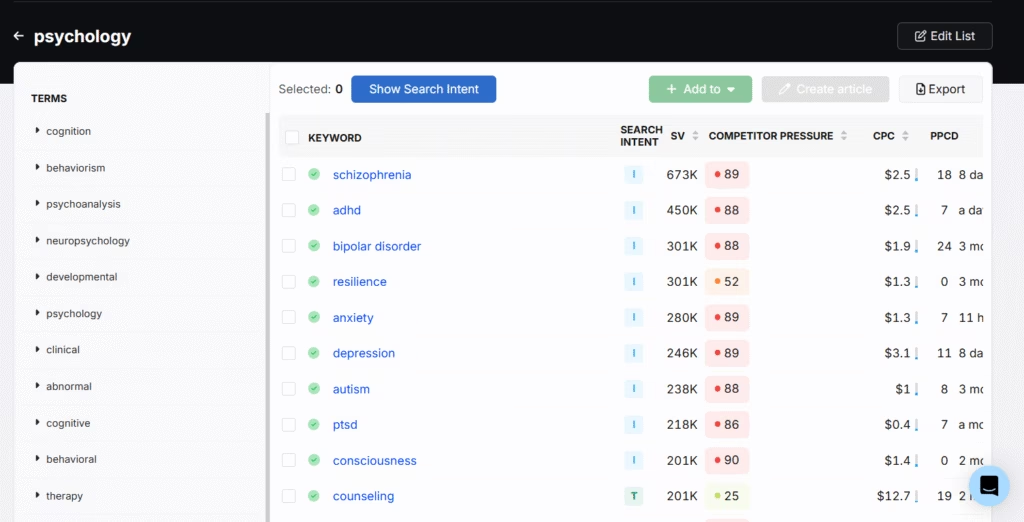
The Search Atlas Keyword Gap Tool compares the keyword performance of your website with up to six competitors to reveal high-value terms your competitors rank for but you don’t, and highlight gaps in your content strategy. The Search Atlas Keyword Gap Tool enables you to expand your keyword coverage, target new search queries, and strengthen your competitive position in search results.
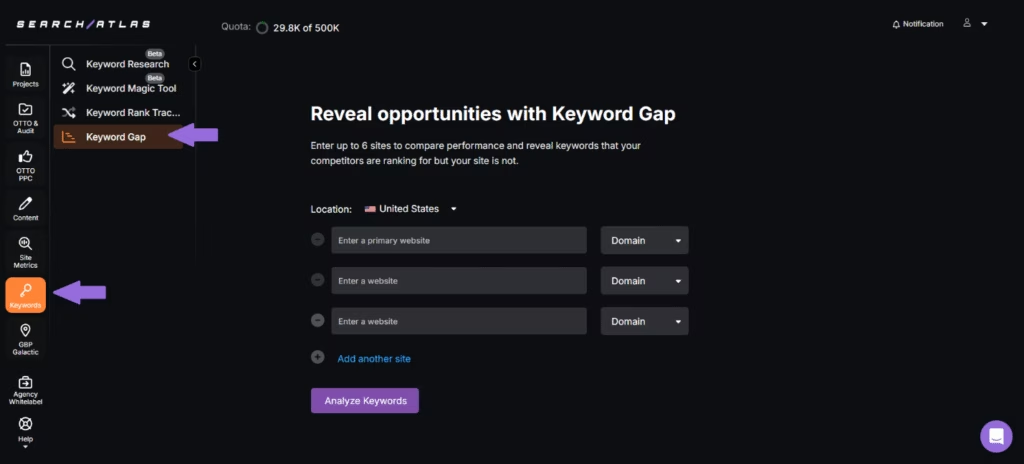
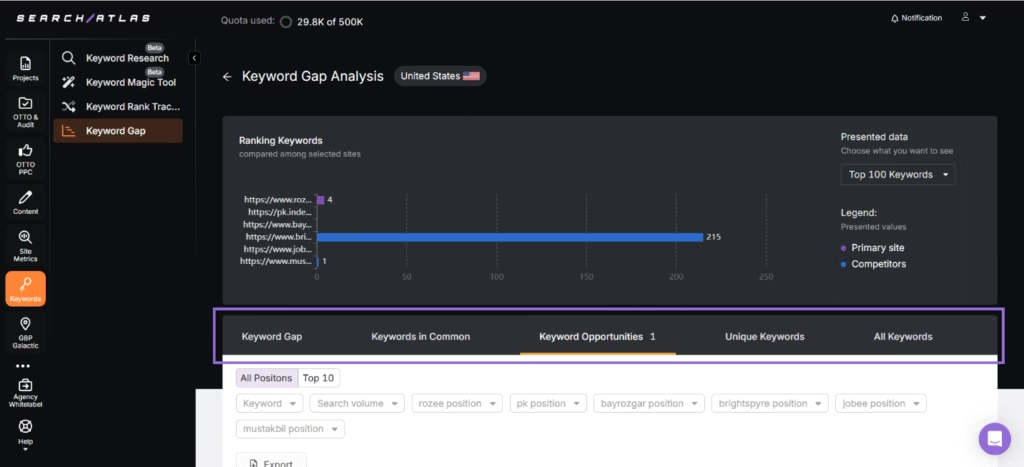
2. Create a Topical Map
A topical map is a structured content planning framework that organizes related topics, subtopics, and keywords around a central theme. A topical map serves as a visual or strategic representation of how content pieces connect to each other, helping to build topical authority and improve SEO performance. The main elements of a topical map are pillar content (main themes) and cluster content (supporting subtopics), all internally linked to guide both users and search engines.
Creating a topical map improves search engine authority and rankings through comprehensive topic coverage. Systematically addressing all aspects of a subject area helps search engines recognize your website as an authoritative source, leading to better rankings across multiple related keywords.
Developing topical maps prevents content gaps and duplication by providing a clear overview of what content exists and what still needs to be created. The strategic approach improves user experience by creating logical content pathways that guide visitors through related topics, increasing engagement and time spent on your website. Additionally, topical mapping helps identify content opportunities that competitors might have missed while guaranteeing efficient resource allocation by prioritizing high-impact topics that align with business goals.
The best practices for creating a topical map are listed below.
- Choose a core topic that aligns with your business goals and target audience.
- Conduct keyword research to identify subtopics, questions, and long-tail phrases related to your core topic.
- Group related keywords and ideas into clusters that support a central pillar page.
- Create high-quality pillar content that broadly covers the main topic.
- Develop cluster content that explores each subtopic in-depth and links back to the pillar page.
- Use internal linking between pillar and cluster pages to reinforce topic relevance.
- Consider user intent and content gaps while organizing your map.
- Update your topical map regularly as search trends and audience needs evolve.
- Use visual tools like mind maps or spreadsheets to keep your map organized.
- Track performance with analytics tools to refine and expand your topical coverage over time.
The Search Atlas Topical Maps Tool is specifically designed to help you build relevant, SEO-friendly topic clusters around your target keywords or themes. The Search Atlas Topical Maps Tool allows you to define the number of clusters (or categories) you want to create, making it easy to organize your content in a structured and strategic way. The Search Atlas Topical Maps Tool helps you streamline your content planning process and lay a strong foundation for an effective topic cluster strategy that drives higher visibility and engagement.
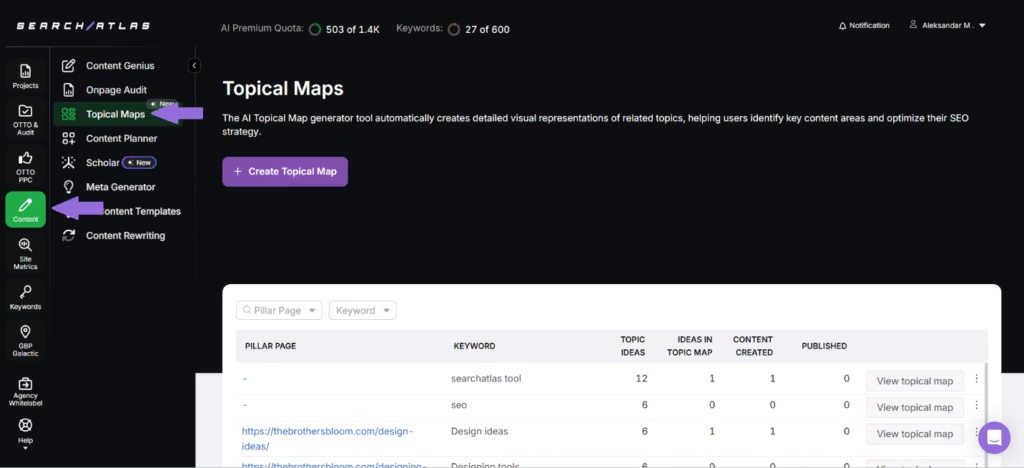
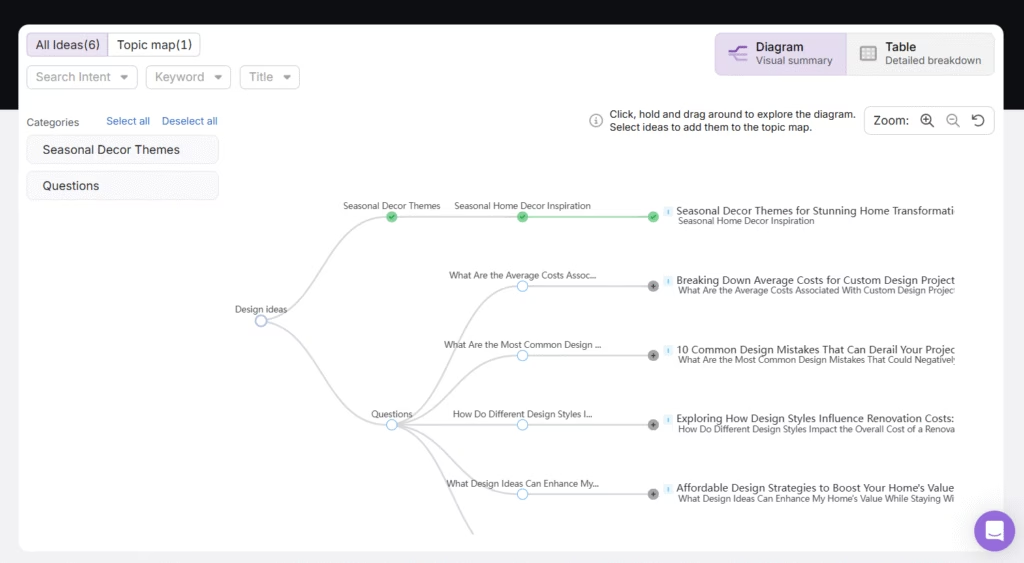
3. Optimize Existing Website Content
Optimizing existing website content refers to the process of improving and refining the text, images, videos, and other elements on your web pages to make them more valuable for users and more discoverable by search engines. Optimizing existing website content involves refining on-page elements like headings, keywords, internal links, meta tags, images, and overall readability to ascertain your content ranks higher in search results and delivers value to your audience.
Improving existing website content helps increase your visibility on search engines by making sure your pages are aligned with SEO best practices and user intent. Properly optimizing website content helps it rank better, drive more targeted traffic, and keep visitors engaged longer. Regularly updating website content improves user experience by making the content easier to read, navigate, and understand. Additionally, regularly optimized content stays up-to-date and relevant, which helps maintain or boost rankings over time.
To optimize existing website content, start by using tools like the Search Atlas Scholar Tool and the Search Atlas On-Page Audit Tool to audit your existing content and evaluate its relevance, structure, and depth around a targeted keyword. Leverage the Search Atlas Content Genius Tool to optimize the existing content with relevant keywords, topical terms, and links. Include the primary keyword naturally in the text as well as in the title tag and H1 tag. Write compelling meta titles and descriptions to improve click-through rates in search results. Use proper heading tags (H1, H2, H3) to structure your content clearly. Make sure the content is clear, concise, and aligned with the user’s search intent.
Additionally, add internal links to related pages to guide users and distribute page authority. Include relevant external links to high-authority sources to build credibility. Optimize images with descriptive file names and alt text for accessibility and SEO.
The Search Atlas Scholar Tool grades your content against Google’s Page Quality Algorithm and information retrieval principles and provides clear, actionable insights to help you improve content quality and search performance. To review your content using the Search Atlas Scholar Tool, simply enter your target keyword, upload your content, URL, or draft, and click “Analyze Page.” The Search Atlas Scholar Tool will then assess your content from all angles and generate a data-driven score, highlighting specific areas for optimization.
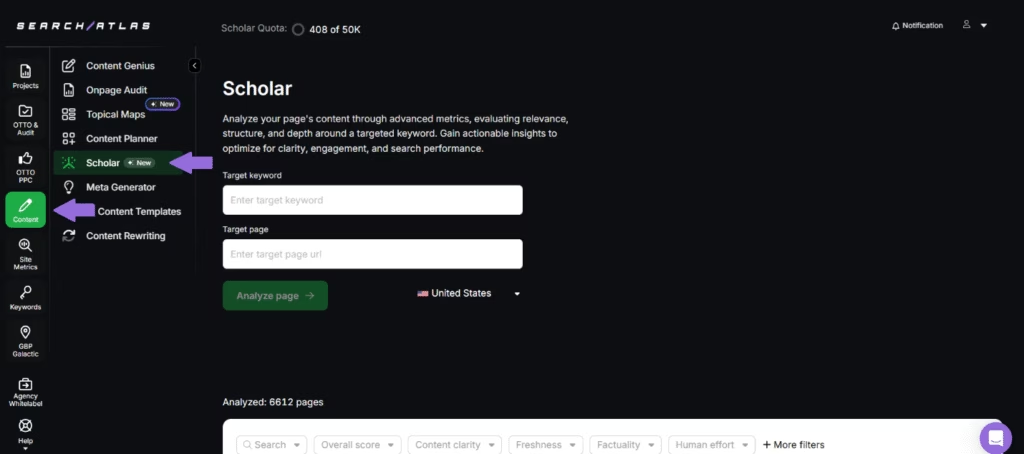
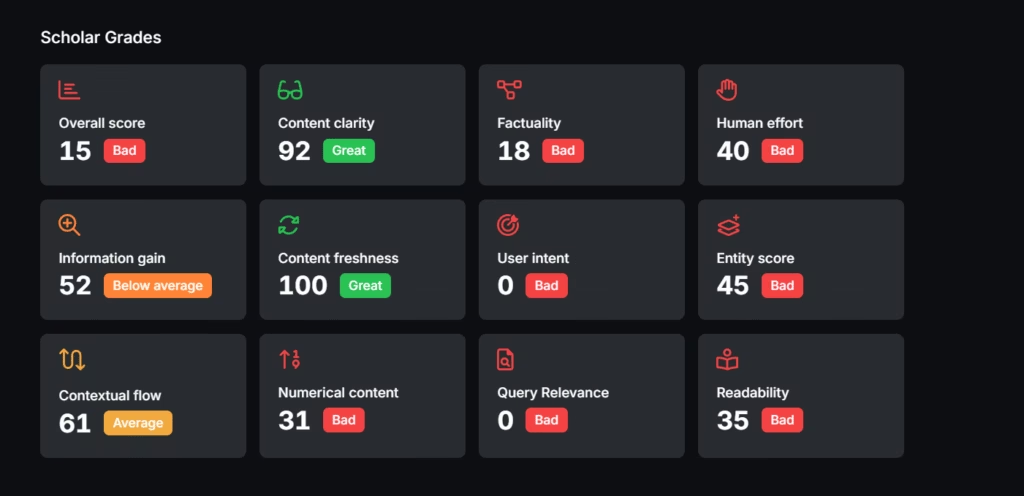
Additionally, the Search Atlas On-Page Audit Tool evaluates your content quality and SEO by analyzing key elements such as content score, word count, and readability. The Search Atlas On-Page Audit Tool allows you to compare your page against the top 10 ranking competitors for your target keyword to identify the areas where your content may fall short and need improvement. With detailed insights and guidance, the Search Atlas On-Page Audit Tool makes sure your content is relevant and engaging and aligns with what search engines prioritize to help you improve visibility, boost rankings, and better connect with your target audience.
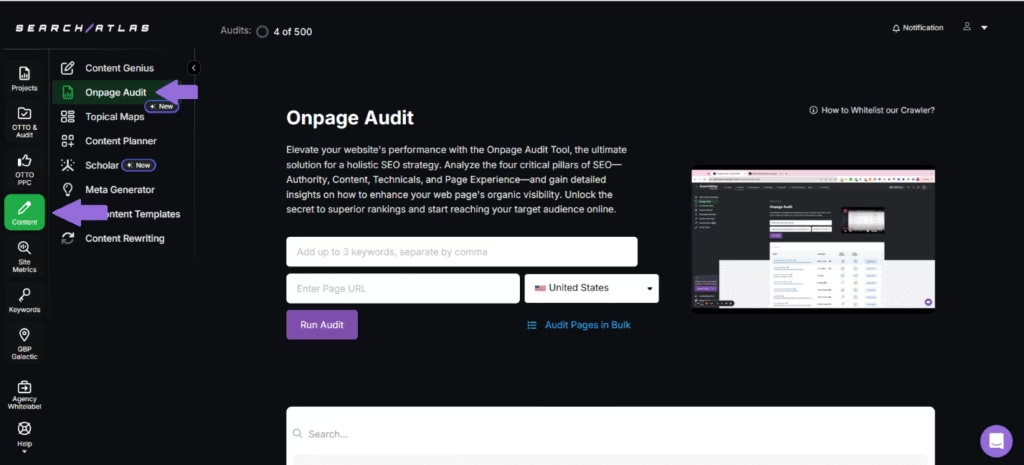
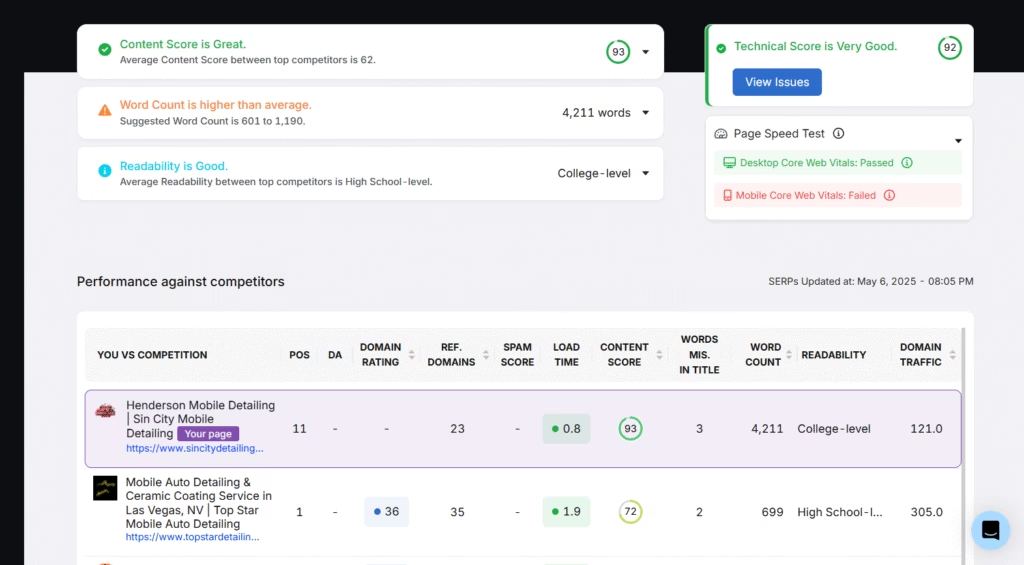
The Search Atlas Content Genius Tool is an AI-powered tool designed to simplify and improve the content creation and optimization process. The Search Atlas Content Genius Tool combines integrated keyword research, SERP analysis, and NLP-driven suggestions to help you create SEO-optimized articles effortlessly. The Search Atlas Content Genius Tool analyzes top-performing content for your target keywords and generates detailed content briefs, including suggested headings, relevant questions, topical terms, and recommended links.
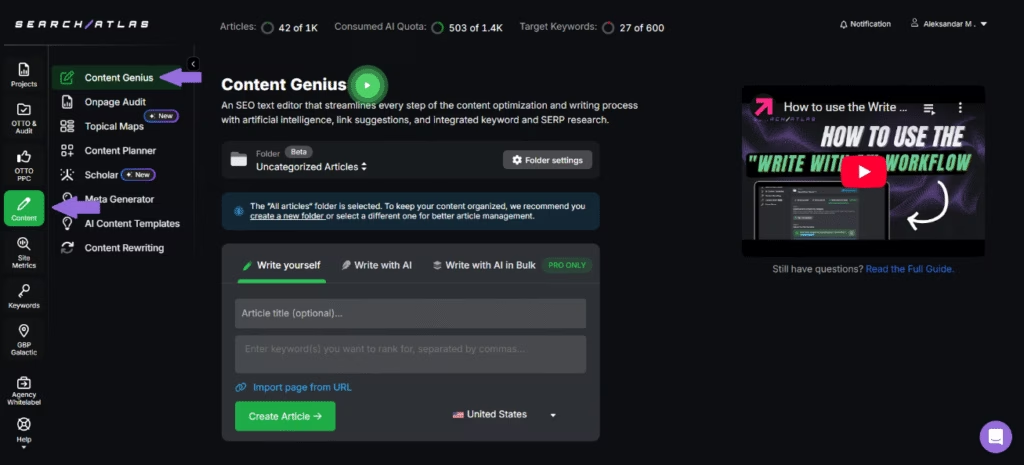
4. Create and Publish SEO-Friendly Content
Creating and publishing SEO-friendly content involves developing high-quality, valuable content that is strategically optimized to rank well in search engine results. The process combines compelling writing, strategic keyword integration, proper formatting, and technical optimization to create content that both search engines can easily understand and users find engaging and useful.
Creating and publishing SEO-friendly content helps your website gain more visibility on search engines, which in turn drives organic traffic. Creating and publishing optimized content consistently builds topical authority in your niche, making it more likely that both users and search engines will see your site as a trusted resource. Additionally, high-quality, SEO-friendly content improves user experience by being clear, useful, and easy to navigate, leading to longer visit durations, lower bounce rates, and higher conversion potential.
The tips to create and publish SEO-friendly content are given below.
- Use the Search Atlas Content Genius Tool to create content optimized for SEO.
- Align your content with user search intent (informational, transactional, navigational, etc.).
- Use keywords naturally in titles, headings, meta descriptions, and throughout the content.
- Structure your content with headings (H1, H2, H3) to improve readability and SEO.
- Use an appropriate tone, language level, and style that resonates with your intended readers.
- Optimize meta tags, URL slugs, and image alt text for better indexing and accessibility.
- Write compelling and valuable content that satisfies user queries and encourages engagement.
- Include internal and external links to support content authority and provide more value.
- Format content for readability with short paragraphs, bullet points, and visuals.
- Maintain a regular content publishing schedule to keep your site active and fresh.
- Keep information current and add new insights to maintain relevance and search rankings.
- Track content performance through analytics and make improvements based on user behavior and ranking data.
The Search Atlas Content Genius tool helps you create SEO-friendly content by streamlining keyword integration, optimizing on-page elements, and guaranteeing alignment with search intent. The Search Atlas Content Genius Tool generates detailed content briefs with optimized headings, relevant questions, and topical terms based on top-performing content to help users craft high-ranking articles with ease.
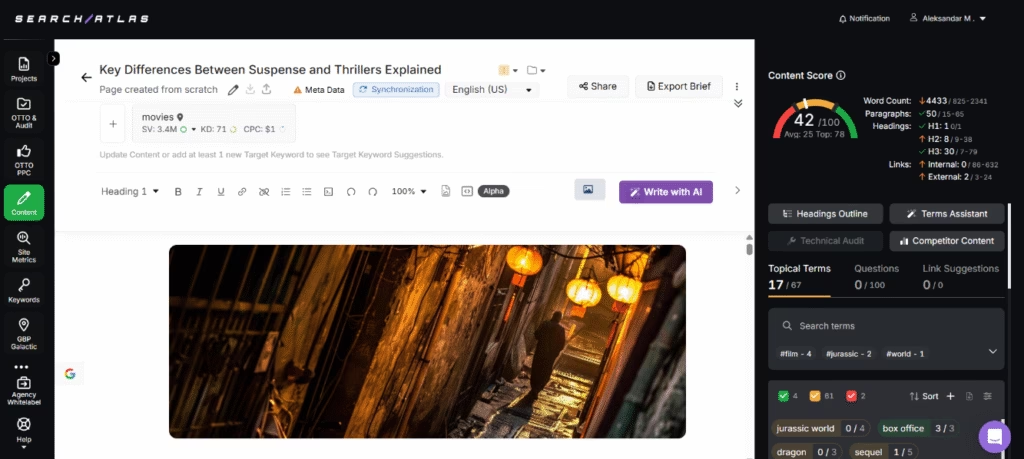
5. Assess and Improve Technical SEO
Technical SEO refers to optimizing the backend structure and foundation of your website to help search engines crawl, index, and understand your content more effectively. Technical SEO makes sure that your site meets all the technical requirements of modern search engines, which directly affects your rankings and organic visibility.
Assessing and improving technical SEO significantly improves overall search performance by removing barriers that might prevent search engines from properly understanding and ranking your content. Assessing and improving technical SEO often leads to a better user experience through faster page loading, proper mobile rendering, and intuitive site navigation. Technical SEO improvements reduce bounce rates and increase engagement metrics, which indirectly benefit search rankings as signals of content quality and relevance.
The best practices for assessing and improving technical SEO are mentioned below.
- Use tools like Google Search Console or the Search Atlas Site Auditor Tool to perform regular technical SEO audits.
- Check for crawl errors and fix broken links or incorrect redirects.
- Verify that your site has a clean and simple URL structure.
- Improve page loading speed by compressing images, minimizing code, and enabling caching.
- Implement HTTPS to secure your website and boost trust.
- Make your website mobile-friendly with a responsive design.
- Submit an up-to-date XML sitemap to search engines for better indexing.
- Use robots.txt to control which pages search engines can or cannot crawl.
- Fix duplicate content issues using canonical tags.
- Add structured data (schema markup) to help search engines understand your content.
The Search Atlas Site Auditor Tool provides a detailed overview of your website’s technical performance by identifying issues related to crawlability, indexability, and site structure. Simply enter your domain, set the maximum number of pages to crawl, configure the crawl frequency, and click “Start Audit.” The Search Atlas Site Auditor Tool then scans your pages and highlights the most critical SEO issues using customizable Page Explorer reports.
The Search Atlas Site Auditor Tool allows you to combine crawl data with metrics from Google Search Console and Google Analytics to help you quickly identify problems on your most important landing pages. This type of targeted, data-driven analysis makes sure your website’s technical foundation is solid and supports better search visibility and long-term SEO success.
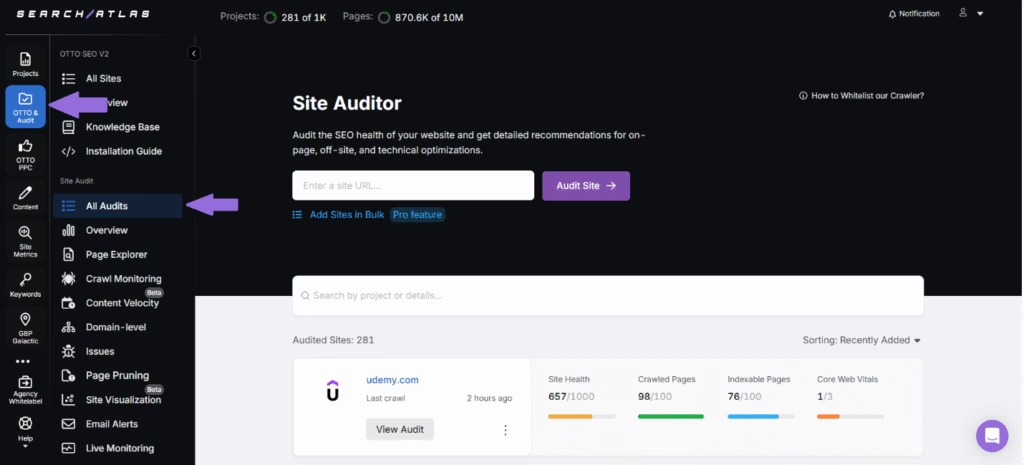
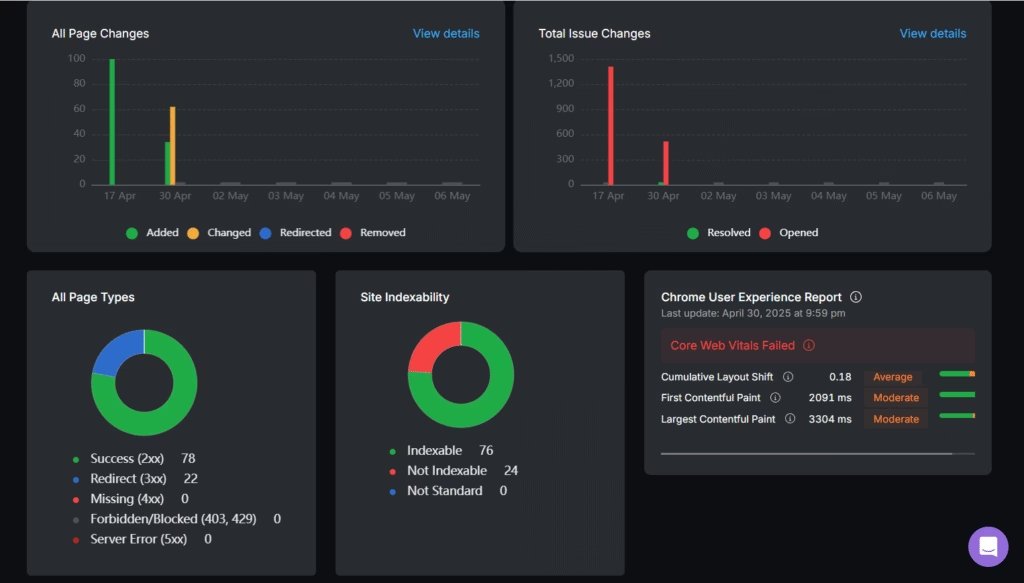
6. Build Quality Backlinks
Building quality backlinks is the strategic process of earning hyperlinks from other websites to your own. These external links act as votes of confidence or endorsements from one site to another, signaling to search engines that others vouch for your content’s value and credibility.
Building quality backlinks improves SEO by boosting your site’s domain authority, helping search engines discover your pages faster, and increasing your chances of ranking higher in search engine results. Building quality backlinks drives referral traffic from relevant audiences already interested in your industry or topic, bringing engaged visitors who are more likely to convert. Additionally, acquiring high-quality backlinks improves brand visibility and credibility by associating your site with established authorities in your field.
The tips for building quality backlinks are listed below.
- Create high-value, shareable content such as original research, in-depth guides, infographics, or thought leadership articles.
- Use guest posting on trusted websites in different markets to gain exposure and high-quality backlinks. Use professional platforms like Link Laboratory to guarantee the highest quality of links without the struggle of manually finding websites.
- Leverage broken link building by identifying broken links on other sites and suggesting your content as a replacement.
- Get listed in reputable online directories and industry-specific listings.
- Engage in digital PR with tools like Signal Genesys and collaborate with local media outlets for authoritative mentions and links.
- Engage in strategic partnerships and collaborations with influencers or complementary businesses.
- Promote your content on social media to increase visibility and the likelihood of earning natural backlinks.
- Use tools like the Search Atlas Backlink Research Tool to identify linking opportunities.
The Search Atlas Backlink Research Tool is a powerful resource for identifying valuable link-building opportunities. The Search Atlas Backlink Research Tool provides comprehensive domain and page-level insights for any website, URL, or subdomain, allowing you to identify where and how your competitors are earning their backlinks. With detailed backlink metrics, historical link trends, and anchor text analysis, the Search Atlas Backlink Research Tool helps you discover high-quality linking opportunities, track competitor strategies, and improve your website’s authority in global markets.
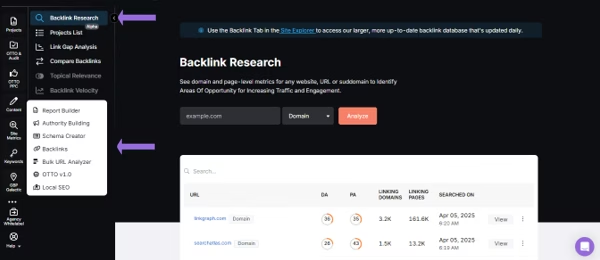
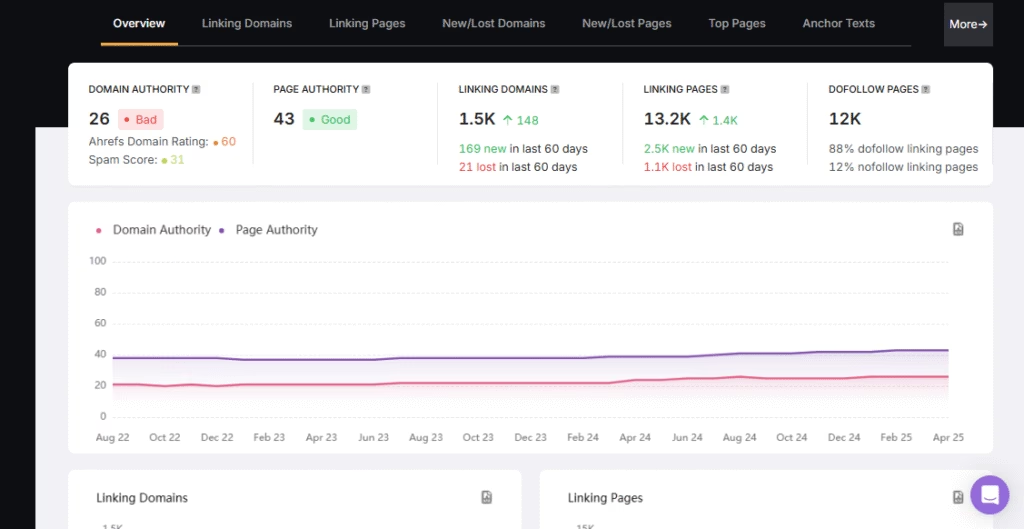
7. Develop an Internal Linking Strategy
An internal linking strategy is the process of creating hyperlinks between pages on the same website to guide users and search engines through your content. These links help establish a logical site structure, distribute page authority, and improve navigation. Internal links can include links in the navigation menu, contextual links within the content, or footer links, each playing a role in connecting related content.
Developing an internal linking strategy improves the user experience by making it easier for visitors to discover related content, stay engaged longer, and explore your website more deeply. An effective internal linking strategy helps search engines discover and index your pages more efficiently. Strategic internal linking passes authority from high-performing pages to others, boosting their visibility in search engine results.
Moreover, a comprehensive internal linking framework allows you to highlight important pages, reduce bounce rates, and guide users toward conversion points such as contact forms, product pages, or blog posts. Over time, this approach contributes to better SEO performance and improved site usability.
To develop an internal linking strategy, create a visual representation of your website structure to identify linking opportunities and content relationships. Focus internal links toward conversion pages, pillar content, and pages you want to rank higher in search results. Use descriptive, keyword-rich anchor text to improve SEO and help users understand what the link is about. Create pillar pages that link to related cluster content, with cluster pages linking back to the pillar. Leverage your strongest pages to pass authority to important but lower-performing pages.
Additionally, make sure important pages are reachable within three clicks from any page on your site. Avoid overloading pages with too many internal links, which can confuse both users and search engines. Run regular internal link audits using tools like the Search Atlas On-Page Audit Tool to identify broken, redirected, or orphaned links. Verify that your navigation and footer include links to key pages for consistent site accessibility. Use breadcrumb navigation to help users and search engines understand page hierarchy. Monitor user behavior with tools like Google Analytics to optimize internal link placement for engagement.
The Search Atlas On-Page Audit Tool serves as an effective way to check and optimize internal linking across your website. The Search Atlas On-Page Audit Tool helps identify broken links that disrupt user experience, orphaned pages that are not linked from any other part of your site, and redirect chains that can waste crawl budget and slow down site performance.
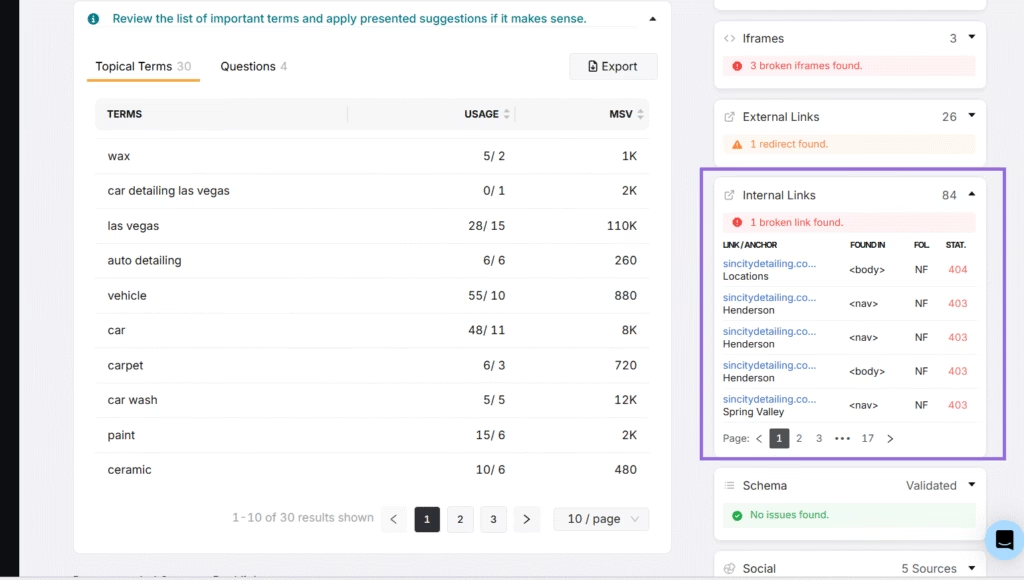
Additionally, the Search Atlas On-Page Audit Tool provides internal linking recommendations to strengthen your site’s structure by improving navigation, increasing crawlability, and guaranteeing better distribution of link equity.
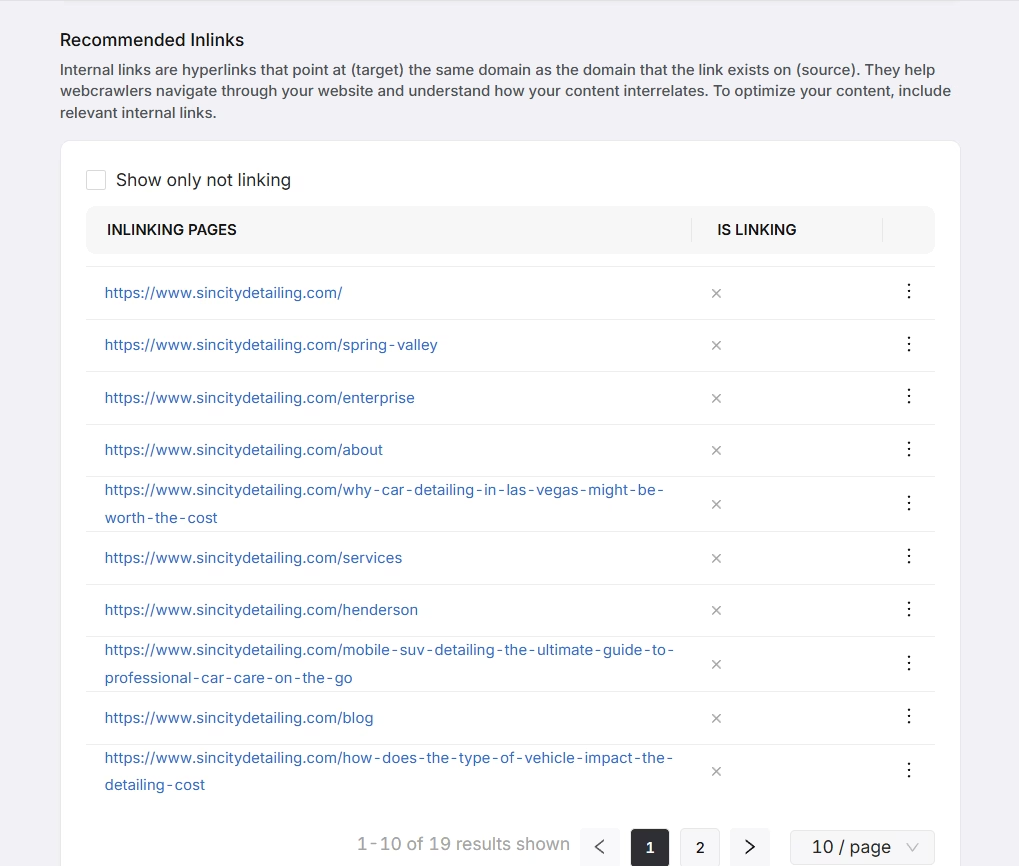
8. Measure and Track SEO Success
Measuring and tracking SEO success refers to the ongoing process of monitoring key performance indicators (KPIs) to evaluate how well your SEO strategies are working. Measuring and tracking SEO success involves analyzing data from various tools and platforms to understand your website’s organic visibility, keyword rankings, traffic quality, user behavior, and conversions.
Regularly measuring and tracking your SEO performance provides crucial insights into what is working and what needs improvement. Reviewing SEO success consistently can help you identify which pages are generating the most traffic, which keywords are driving visitors, and where you might be losing opportunities. This knowledge allows for informed decision-making, helping you adjust your strategies to boost rankings and conversions more effectively.
Additionally, monitoring and evaluating SEO performance helps you justify the return on investment (ROI) of your SEO efforts and demonstrates progress over time. Tracking and analyzing SEO outcomes ensures that you remain aligned with your business goals and provides the clarity needed to scale successful tactics while eliminating ineffective ones.
The tips for measuring and tracking SEO success are outlined below.
- Set clear SEO goals and KPIs (e.g., organic traffic, keyword rankings, bounce rate, conversions).
- Use tools like Google Analytics and Search Console to monitor traffic, impressions, and click-through rates.
- Leverage tools like the Search Atlas Keyword Rank Tracker Tool to track keyword rankings regularly and assess your visibility in search results.
- Analyze user behavior metrics like time on page, bounce rate, and pages per session.
- Monitor backlinks to assess domain authority and identify new linking opportunities.
- Review technical SEO performance, including crawl errors, page speed, and mobile usability.
- Compare current performance with past data to measure growth trends and identify patterns.
- Segment data by device, location, and source to gain deeper insights into your audience.
- Set up conversion tracking to understand how organic traffic contributes to business goals.
- Create regular SEO reports to visualize progress and communicate results to stakeholders.
The Search Atlas Keyword Rank Tracker Tool automatically checks the rankings of your target keywords at your chosen frequency and provides insights into key metrics, including current position, search volume, SERP features, and ranking trends over time, to help you evaluate your keyword performance and adjust your SEO strategy accordingly. Additionally, the Search Atlas Keyword Rank Tracker Tool provides a detailed overview of the number of keywords your competitors have in the top 10 and the rate of their search visibility to help you identify content gaps and possible ranking opportunities.
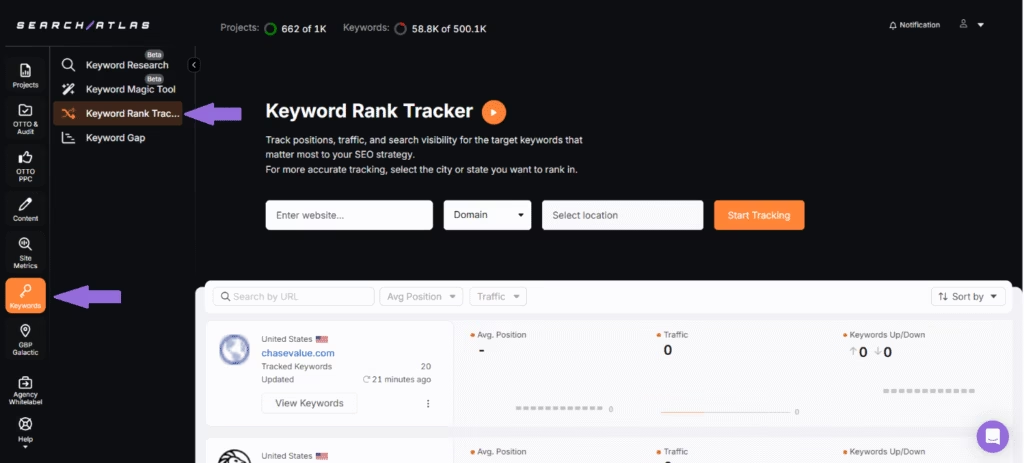
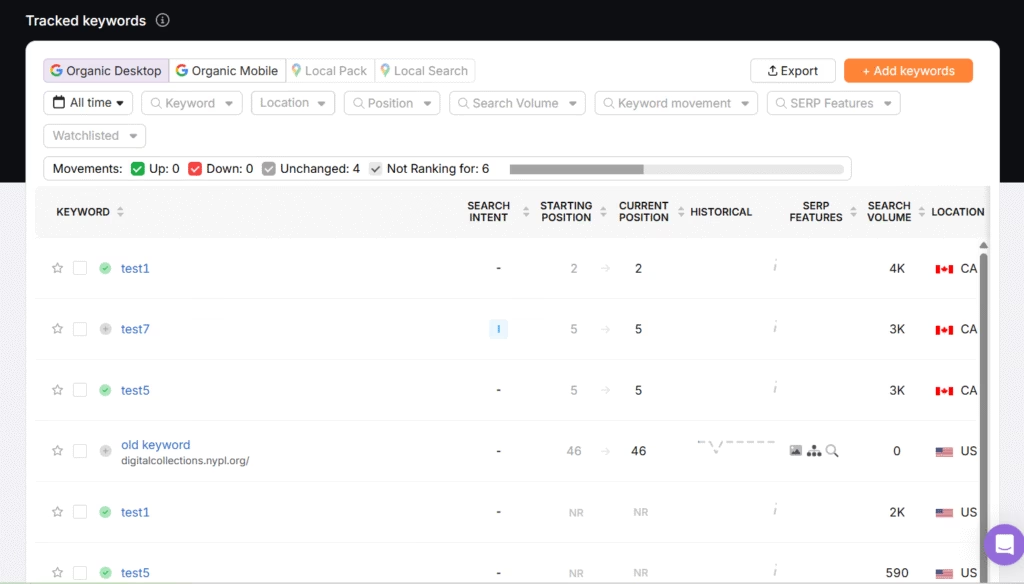
Is DIY SEO Easy SEO for Beginners?
Yes, DIY SEO can be easy for beginners, provided they are willing to invest time and effort into learning the fundamentals.
Search engine optimization may seem complex at first, but many of the SEO basics, such as keyword research and writing optimized content, are accessible to those new to the field. The abundance of free online resources, guides, and beginner-friendly tools assists individuals in gradually building their knowledge and applying proven strategies without relying on professional agencies.
However, DIY SEO for beginners does come with a learning curve. Areas like technical SEO, competitive analysis, and link building may require more advanced understanding and experience. Beginners should be prepared for continuous learning and experimentation, as results often take time and consistent effort to achieve.
How to Do DIY SEO Audit?
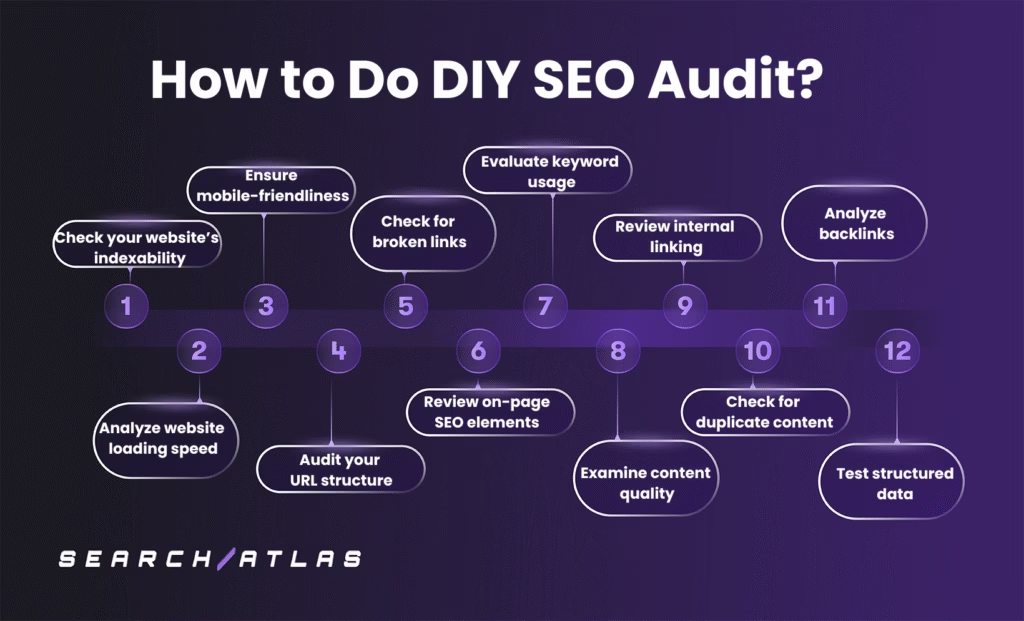
There are 12 steps to conduct a DIY SEO audit and evaluate and improve your website’s search engine performance. The 12-step DIY SEO website audit is given below.
- Check your website’s indexability. Use the site:yourdomain.com search operator on Google to see which of your pages are indexed. There may be issues with your sitemap, robots.txt file, or noindex tags if important pages are missing.
- Analyze website loading speed. Use tools like Google PageSpeed Insights or GTmetrix to assess your site’s performance and get actionable recommendations to improve load times.
- Ensure mobile-friendliness. Test your website using a Mobile-Friendly Test and address any usability issues it identifies, such as unreadable text, touch elements that are too close, or content that does not fit the screen properly. Since Google uses mobile-first indexing, your website must perform well on mobile devices.
- Audit your URL structure. Make sure your URLs are short, descriptive, and include relevant keywords. Avoid long strings of numbers or irrelevant characters, which can harm both user experience and SEO.
- Check for broken links. Use tools like the Search Atlas Site Auditor Tool to identify 404 errors or dead outbound links. Update or remove broken links to improve user experience and maintain crawlability.
- Review on-page SEO elements. Examine key on-page components like title tags, meta descriptions, H1 and H2 headings, image alt attributes, and content structure. These elements should be optimized with your target keywords and clearly reflect the content of the page.
- Evaluate keyword usage. Check whether your content targets relevant keywords and includes them naturally in key areas like headings, the introduction, and throughout the body text, without keyword stuffing.
- Examine content quality. Review your pages for clarity, originality, and depth. Make sure your content aligns with user intent and offers valuable insights, rather than just repeating what is already out there.
- Review internal linking. Ensure your internal links guide visitors to related pages and help distribute page authority. Important pages should be easily accessible through a clear and strategic linking structure.
- Check for duplicate content. Use tools like Copyscape or Siteliner to detect any duplicate content issues that might harm your SEO. Consolidate or update similar pages to maintain unique, high-quality content.
- Analyze backlinks. Evaluate the quality and quantity of sites linking to you. Use Google Search Console or the Search Atlas Backlink Research Tool to monitor your backlink profile and disavow toxic links if necessary.
- Test structured data. Use Google’s Rich Results Test to check if your schema is implemented correctly. Add schema for articles, products, reviews, FAQs, and more, depending on your content type.
Conducting a DIY SEO audit using these steps gives you greater control over your website’s performance and helps you stay aligned with SEO best practices. Performing a DIY SEO audit may take some time initially, but it is a worthwhile investment that can lead to significant improvements in visibility and traffic.
What Are the DIY SEO Tools?
The DIY SEO tools include the free, foundational tools from Google and the advanced SEO tools from the Search Atlas SEO Software Platform.
Google’s free tools are a great starting point for beginners and small business owners. Google Search Console helps you monitor your website’s visibility in Google search results and provides valuable insights into keyword performance, crawl errors, index status, and mobile usability issues. Google Analytics allows you to track and understand user behavior, such as where visitors come from, which pages they interact with most, and how long they stay on your site, helping you make data-driven decisions to improve engagement and conversions.
Google Keyword Planner, designed originally for Google Ads, is incredibly useful for discovering high-volume, low-competition keywords for your SEO content strategy. Google PageSpeed Insights analyzes both mobile and desktop performance and suggests specific optimizations to improve user experience. Finally, Google Trends helps you identify trending search queries and compare keyword interest over time, making it easier to plan timely and relevant content.
The Search Atlas SEO Software Platform, on the other hand, is perfect for those looking for more in-depth capabilities. The Search Atlas Keyword Research Tool provides comprehensive keyword data and helps you discover emerging opportunities, search trends, and related terms to build a data-driven SEO strategy. The Search Atlas Keyword Gap Tool compares your website’s keyword performance with up to six competitors to uncover high-value keywords you are missing and content gaps in your strategy. The Search Atlas Topical Maps Tool helps you create structured, SEO-friendly topic clusters around your main keywords to improve content organization and search relevance.
The Search Atlas Scholar Tool analyzes your content against Google’s Page Quality guidelines and offers actionable insights to enhance quality and boost rankings. The Search Atlas On-Page Audit Tool evaluates your page’s SEO, highlighting areas to improve content score, word count, and readability. The Search Atlas Content Genius Tool uses AI to generate SEO-optimized content briefs with keyword suggestions, headings, and topical terms based on SERP analysis.
Additionally, the Search Atlas Site Auditor Tool scans your website for technical SEO issues related to crawlability, indexability, and structure, and presents findings in detailed reports. The Search Atlas Backlink Research Tool identifies where your competitors earn backlinks and reveals opportunities to strengthen your site’s authority through strategic link-building. Finally, the Search Atlas Keyword Rank Tracker Tool tracks your keyword rankings over time, monitors competitor performance, and provides actionable insights to refine your SEO approach.
Using the right DIY SEO tools can significantly simplify the process of optimizing your website and help you achieve better results without relying on external agencies. Leveraging the best DIY SEO software empowers you to make informed decisions and drive sustainable growth through hands-on SEO efforts.
What Businesses Need DIY SEO the Most?
There are certain types of businesses that stand to gain the most from DIY SEO due to budget constraints, competitive digital landscapes, or the need for strong online visibility to drive traffic and conversions. The businesses that need DIY SEO the most are outlined below.
- E-commerce Businesses. E-commerce businesses need DIY SEO because they operate in a highly competitive digital marketplace where visibility can directly impact sales. These businesses rely on search engine optimization to stand out in SERPs from the countless online stores selling similar products. E-commerce SEO allows e-commerce businesses to optimize product pages, improve site structure, and target high-intent keywords, which drives more organic traffic to the store. This strategy improves visibility and brand awareness, enhances user experience, and boosts conversions, making e-commerce SEO a vital, cost-effective strategy for sustainable online growth.
- Professional Service-Based Businesses. Professional service-based businesses require DIY SEO because potential clients often search online for trusted experts in fields like law, healthcare, finance, or consulting. These businesses may miss out on valuable leads and opportunities if they do not appear in relevant search results. SEO for service-based businesses helps build online credibility, improves local search visibility, and ensures that their services are easily discoverable by their target audience. By optimizing service pages, using local SEO tactics, and creating valuable content, these businesses can attract more qualified inquiries and establish themselves as authoritative solutions in their niche.
- SaaS and Tech Companies. SaaS and tech companies rely on DIY SEO because their target customers often rely on search engines to research software solutions, compare features, and find trustworthy providers. Visibility in search results is critical for these businesses to drive awareness and generate leads with a digital-first audience. SaaS SEO helps improve rankings for competitive keywords, showcases product value through optimized content, and supports customer acquisition with targeted landing pages. Investing in SaaS SEO helps these businesses build long-term organic traffic, reduce reliance on paid ads, and position themselves as industry leaders.
- Startups and SMEs. Startups and SMEs depend on DIY SEO because they often operate with limited marketing budgets and need cost-effective ways to build visibility, trust, and traction in their early stages. These businesses may find it challenging to compete with established brands without a strong online presence. SEO for startups and SMEs helps improve their discoverability in search results, attract targeted traffic, and generate leads organically. SEO for startups and SMEs helps them build credibility, grow their audience, and scale their business through optimized content, local SEO, and technical enhancements without heavily relying on paid promotions.
- Small Local Businesses. Small local businesses invest in DIY SEO because their customers often search online for nearby services, products, or solutions before making a purchase. These businesses risk losing foot traffic and local visibility to competitors if they do not appear in local search results. Small business SEO focuses on optimizing for location-based keywords, setting up and managing Google Business Profiles, and earning positive local reviews. Small business SEO helps small local businesses show up in local map packs and search listings, attract more nearby customers, and build a loyal community presence that drives sustainable growth.
- Travel Businesses. Travel businesses need DIY SEO because travelers increasingly plan their trips online, researching destinations, accommodations, and experiences through search engines. Travel companies may miss out on potential bookings and inquiries if they lack strong visibility in search results. Travel SEO helps improve rankings for destination-specific and service-related keywords, enhances visibility during seasonal peaks, and drives traffic through engaging informative content. Travel SEO helps travel companies attract more organic visitors, increase conversions, and build lasting brand awareness in a highly competitive industry by optimizing their websites and content for both local and international search intent.
- Restaurants and Cafés. Restaurants and cafes invest in DIY SEO because potential customers frequently search online for places to eat nearby, read reviews, view menus, and check opening hours. These businesses may not appear in local search results and lose foot traffic to competitors without proper optimization. Restaurant SEO helps improve visibility in local map packs and search listings by optimizing their Google Business Profile, using location-based keywords, and encouraging positive reviews. Effective restaurant SEO helps restaurants and cafes attract more diners, boost reservations or takeout orders, and build a strong presence in their local food scene.
- Seasonal Businesses. Seasonal businesses need DIY SEO because their products or services are only in demand during specific times of the year, making it essential to capture maximum visibility during those peak periods. Seasonal SEO involves planning content and keyword strategies ahead of time, optimizing for seasonal trends, and ensuring technical readiness for traffic surges. With effective seasonal SEO, seasonal businesses can dominate search results during peak seasons, drive more targeted traffic, and maximize their revenue within a limited sales window.
By embracing DIY SEO, these businesses can take control of their online growth, build brand authority, and reach customers without relying entirely on paid advertising. DIY SEO offers these businesses a sustainable, long-term approach to digital visibility that supports both branding and conversions.
What Are the Common DIY SEO Mistakes to Avoid?
Many business owners and website managers make critical errors when attempting SEO on their own, often unknowingly sabotaging their search engine performance. Understanding these common pitfalls is essential for anyone pursuing a DIY SEO approach, as these mistakes can result in penalties, poor rankings, or wasted time and resources that could have been avoided with proper knowledge. The common DIY SEO mistakes to avoid are mentioned below.
- Absence of a topical map strategy. The lack of a topical map strategy means your content lacks organization and focus. Failure to ensure topical relevance may make it difficult for search engines to understand how your pages relate to each other and to the overall theme of your site.
- Presence of irrelevant keyword targeting. Targeting keywords that don’t align with your audience’s actual search intent can bring visitors who are not interested in your offerings. This unqualified traffic leads to high bounce rates, low engagement, and poor conversion rates.
- Lack of contextual relevance in content. Content that does not address the user’s questions or provide meaningful, related information will fail to engage visitors. Search engines favor content that provides comprehensive answers and fits naturally within the topic, so lacking this relevance can reduce your rankings and hurt your credibility.
- Poor interlinking structure and architecture. Internal links help search engines crawl your website and distribute ranking power across pages. A poor linking structure, such as missing links between related pages or too many orphaned pages, can confuse search engines and prevent your most important content from ranking well.
- Neglecting on-page SEO elements. Ignoring key on-page SEO factors like optimized meta titles, descriptions, header tags, and image alt attributes means missing valuable ranking signals. These elements help search engines understand your content and improve click-through rates from search results.
- Ignoring technical SEO issues. Technical problems such as slow page load times, mobile usability issues, broken links, or poor crawlability can significantly impact your site’s ability to rank. Search engines prioritize sites that offer a smooth and accessible user experience, so technical SEO issues should never be overlooked.
- Not tracking or measuring SEO performance. Failing to track or measure SEO performance means you won’t have insight into which tactics are working or where adjustments are necessary. Tracking performance is essential for making data-driven decisions and refining your approach.
- Overusing keywords (keyword stuffing). Trying to force keywords unnaturally into your content can lead to penalties from search engines and make your text hard to read. SEO today requires a natural, user-focused approach rather than keyword stuffing.
- Neglecting backlink building. Backlinks from reputable websites are a major ranking factor. DIY SEOs often overlook outreach and link-building efforts, missing out on opportunities to increase domain authority and search visibility.
- Failing to update old content. Search engines favor fresh, relevant content. Allowing older posts to become outdated means losing ranking positions and traffic potential. Regularly updating your content ensures it remains accurate and competitive.
- Skipping local SEO optimization. Ignoring local SEO practices, such as optimizing for local keywords, maintaining accurate Google Business Profiles, and collecting customer reviews, can cause businesses targeting local customers to miss out on valuable local search traffic.
Avoiding these common DIY SEO mistakes is crucial for building a strong and effective online presence. Steering clear of these pitfalls makes sure that your SEO efforts are strategic, targeted, and yield measurable results.
What is the Relation Between DIY SEO and Programmatic SEO?
DIY SEO and programmatic SEO are closely related in that both empower individuals or businesses to manage and scale their search engine optimization efforts independently, often without relying on traditional SEO agencies.
DIY SEO refers to the process of optimizing your website for search engines by handling all aspects of SEO on your own or without hiring professional consultants or agencies. DIY SEO is commonly used by small business owners, bloggers, and startups who aim to increase visibility while maintaining control and reducing costs.
Programmatic SEO, on the other hand, is the practice of using automated tools, scripts, or platforms to generate large volumes of SEO-optimized pages at scale. Programmatic SEO is especially useful for websites with vast data sets or repetitive page templates, like directories, e-commerce platforms, or travel sites, allowing them to efficiently target long-tail keywords and enhance discoverability with minimal manual effort.
What to Know About DIY SEO Besides AI SEO?
DIY SEO involves manually managing all aspects of your website’s search engine optimization without relying on external agencies. DIY SEO includes keyword research, content creation, technical audits, link building, and performance tracking, all handled personally or in-house. DIY SEO allows for full control over strategy and execution, often requiring a hands-on approach and ongoing learning.
AI SEO, on the other hand, refers to the use of artificial intelligence-powered tools and platforms to automate, enhance, or streamline SEO tasks. AI SEO tools can analyze data, generate content, identify trends, suggest optimizations, and even execute changes, making SEO more efficient and data-driven.
When combined, DIY SEO and AI SEO can significantly amplify your results, with DIY SEO providing control and customization and AI SEO bringing efficiency and smarter decision-making to the process.









